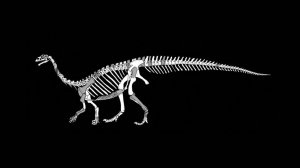South African and Argentinian palaeontologists have named a 200-million year old dinosaur from South Africa‚ “Sefapanosaurus”‚ from the Sesotho word “sefapano”.
The researchers from South Africa’s University of Cape Town (UCT) and the University of the Witwatersrand (Wits University)‚ and from the Argentinian Museo de La Plata and Museo Paleontológico Egidio Feruglio made the announcement in the scientific journal‚ Zoological Journal of the Linnaean Society.
The specimen was found in the late 1930s in the Zastron area of South Africa’s Free State province‚ about 30 km from the Lesotho border.
For many years it remained hidden among the largest fossil collection in South Africa at the Evolutionary Studies Institute at Wits University‚ according to a statement by Wits. A few years ago it was studied and considered to represent the remains of another South African dinosaur‚ Aardonyx. However‚ upon further study‚ close scrutiny of the fossilised bones has revealed that it is a completely new dinosaur.
One of the most distinctive features is that one of its ankle bones‚ the astragalus‚ is shaped like a cross. Considering the area where the fossil was discovered‚ the researchers named the new dinosaur‚ Sefapanosaurus‚ after the Sesotho word “sefapano”‚ meaning “cross”.
Anusuya Chinsamy-Turan‚ co-author and Professor in the Department of Biological Sciences at UCT‚ says: “The discovery of Sefapanosaurus shows that there were several of these transitional early sauropodomorph dinosaurs roaming around southern Africa about 200-million years ago”.
Dr Alejandro Otero‚ Argentinian palaeontologist and lead author‚ says Sefapanosaurus helps to fill the gap between the earliest sauropodomorphs and the gigantic sauropods. “Sefapanosaurus constitutes a member of the growing list of transitional sauropodomorph dinosaurs from Argentina and South Africa that are increasingly telling us about how they diversified.”
Dr Jonah Choiniere‚ co-author and Senior Researcher in Dinosaur Palaeobiology at the Evolutionary Studies Institute at Wits University‚ said: “This new animal shines a spotlight on southern Africa and shows us just how much more we have to learn about the ecosystems of the past‚ even here in our own ‘backyard’.”
Argentinian co-author‚ Dr Diego Pol‚ says Sefapanosaurus and other recent dinosaur discoveries in the two countries reveal that the diversity of herbivorous dinosaurs in Africa and South America was remarkably high back in the Jurassic‚ about 190 million years ago when the southern hemisphere continents were a single supercontinent known as Gondwana.
Sefapanosaurus is considered to be a medium-sized sauropodomorph dinosaur – among the early members of the group that gave rise to the later long necked giants of the Mesozoic.
EMAIL THIS ARTICLE SAVE THIS ARTICLE
To subscribe email subscriptions@creamermedia.co.za or click here
To advertise email advertising@creamermedia.co.za or click here











